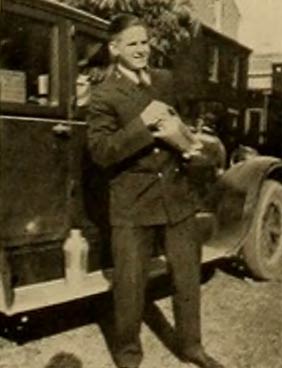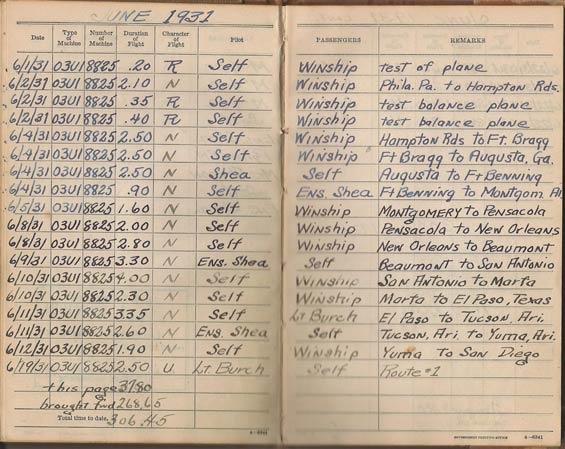|
We are fortunate to have pilot Ahroon's daughter-in-law share with us some details, photographs and documents that illustrate his life in the Navy. She provides the following biographical sketch
BIOGRAPHY OF THOMAS A. AHROON
By Kathy Ahroon
Thomas Andrew Ahroon was born May 3, 1907 in Baltimore, MD. He attended the Baltimore Polytechnic Institute and later the U.S. Naval Academy in Annapolis, MD where he was commissioned an ensign July 6, 1928. Upon graduation, he was assigned to battleship duty where he served in various capacities as a turrent officer, assistant engineer, assistant navigator and communicator. He was assigned to flight training at NAS Pensacola in 1929 and received his wings in 1930.
As an aviator he flew from the battleship PENNSYLVANIA the Fleet Flag ship, and from all of the famous old carriers as a member of the Fighting Five. He had shore duty as a test pilot at Anacostia and for a short time before the war he assisted in building the small Norfolk Air Station.
War time was all “ship time” with billets as navigator, air officer, and executive officer of three carriers in both the Atlantic and the Pacific. His Pacific duties carried him from TARAWA to Tokyo on the WHITE PLAINS and the LEXINGTON. While on the LEXINGTON Captain Ahroon served as Executive Officer to Admiral Robbins who was then skipper of that famous ship.
After the war he served as Aviation Ordance Officer at the Naval Gun Factory, following which he converted and operated for fourteen months the Navy’s first guided missile ship, the NORTON SOUND. As Captain of the NORTON SOUND and acting commodore of a task force to the south seas his favorite story is of bringing his ship into Callao, Peru, when the pilot was too fat to climb on board and none of the deck force could speak Spanish.
Captain Ahroon spent a year at the Industrial College of the Armed Forces and was attached to the Armed Forces Special Weapons Project for duty in connection with the development of atomic weapons. He reported as Chief of Staff, Carrier Division TWO, in August 1952.
He attained the rank of Rear Admiral on July 17, 1956 and won the Legion of Merit, the Bronze Star Medal with Combat V, and a Presidential Unit Citation Ribbon with two stars, the American Defense Service Medal, Asiatic-Pacific Campaign Medal with one silver and four bronze stars, the WWII Victory Medal and the Philippine Liberation Ribbon with two stars. His remark, “These show I am on a team with a lot of men who, felt fear but nevertheless had guts---and got results.”
Rear Admiral Ahroon received a change in orders from General Kuter’s North American Air Defense Command Staff to relieve Rear Adm. Walter F. Rodee as Commander of the Naval Forces, Continental Air Defense Command. He went to his post at NORAD from Washington, D.C., where he was assistant chief of the Bureau of Ordnance. Prior to this duty in Washington D.C., he was commander Carrier Division 17th and was normally deployed in the Far East in the 7th Fleet in command of a Task Group of approximately a dozen ships and submarines with one of the aircraft carriers as his flagship. He headed the top naval post at NORAD from April 1960 to June 1963 when he retired.
NOTE: I found a letter that my father-in-law had written to his mother, dated 20 June 1963 regarding his retirement. In this letter, he writes…
“I feel like crying – I am literally crying tears – not because I am leaving the Navy or its philosophies, but because I am leaving something that is scarce and I might not find any place else – loyalty both up and down. The last previous time I cried was two days after my ship blew up and I had a chance to lie across the bed in my cabin. When I cry it is really a prayer of thanksgiving to God for the men and women who do so much. As I leave the Navy in ten days, I have the wonderful feeling that not once in my 39 Navy years has a man ever let me down. What more can anyone want?”
Not included in this biography: He also served on these ships: the USS BENNINGTON, CVA-20, the USS FRANKLIN D. ROOSEVELT and the USS LEYTE. Just shortly after he was assigned to the USS Leyte, while it was docked, there was an explosion that caused 39 [36] deaths. This may be the explosion he is referring to in the letter to his mother.
|
T.A. Ahroon, USNA, Ca. 1928 (Source: Ahoon via Woodling)
 |
Below is color commentary to complement the biography above. Born and raised in Baltimore, MD, in 1924 he graduated the Baltimore Polytechnic Institute, a city-wide college preparatory high school. He was appointed to the United States Naval Academy (USNA) in 1924 at the young age of 17. When he graduated the Academy in 1928, he went by T. Andrew Ahroon. He was called "Andy" or "Cookie" by his classmates. The latter, perhaps, because he was slightly overweight.
At right is his graduation photograph, taken for his USNA yearbook (courtesy of Ahroon's daughter-in-law and Bob Woodling, cited, right sidebar). The New York Times of June 2, 1928 reported Ahroon's graduation from the Academy. He was one of three Maryland residents among his class of 171. While at the Academy, he served as a battalion subcommander "three striper," ranking as a lieutenant. Below is another photograph from his yearbook. The objects he is handling appear to be martini shakers, which, if they contained alcohol, were illegal at the time (Prohibition was in effect until December, 1933).
Right out of the Academy, as reported in The New York TImes, July 31, 1928, he was assigned to the U.S.S. Arkansas. On January 24, 1931 the TImes reported his assignment, still as an Ensign, aboard the super dreadnaught battleship U.S.S. Pennsylvania then operating in the Pacific. I do not know exactly when he learned to fly, but he became a Naval Aviator at Pensacola, FL.
T.A. Ahroon at Leisure, Ca. 1928 (Source Ahroon via Woodling)
 |
But, Ensign Ahroon arrived at Tucson Thursday, June 11, 1931 at 12:40 PM. He flew a Vought O3U-1 Corsair he identified as A-8825. He carried a single, unidentified passenger. Based at Philadelphia, PA, they were westbound from El Paso, TX to San Diego, CA. No purpose was noted in the Register for their flight. However, from the record in the Register they appeared to be a flight of three with Navy pilots Warren S. Parr flying sister Corsair A-8823, and William W. Shea flying Corsair A-8824. Notably, Joe Baugher's site states that A-8824 sank a few years later during salvage on June 1, 1935 on duty with the U.S.S. Idaho.
Below is the page from Ahroon's flight log book that documents his visit at Tucson. It adds more to the context of his landing. We learn that his journey appears to have started In Philadelphia, PA on June 1st when he tested his airplane, probably at a delivery depot for new aircraft (Corsairs were manufactured at East Hartford, CT at the time).
It is fairly clear that his was a ferry flight of a new airplane to the air station at San Diego. During his cross country flight he carried three different passengers and was himself a passenger when he allowed Ensign Shea to fly the Vought. Visit the link to learn about the O3U line of Vought aircraft.
We also learn that his passenger's name was Lt. Burch, whom he picked up in El Paso, and that their intermediate destination was Yuma, AZ for an overnight stop on their way from Tucson to San Diego. They arrived at San Diego on the 12th where he proceeded to take a week hiatus from flying.
T.A. Ahroon, Flight Log Book, June, 1931 (Source: Ahroon via Woodling)
 |
Question: How many layers do you want to peel from this log book onion? Take, for example, "Winship." He was Kenneth Ivern Winship, a first-class aviation machinist. "Shea" was fellow Register pilot Ensign (later Lt. Cdr.) William Wolcott Shea (1904-1949), fully qualified to fly A-8825. "Lt. Burch" was later highly decorated Rear Admiral William Oscar Burch, Jr. (1904-1989) also fully qualified to fly the Vought.
T.A. Ahroon, Ca. 1937 (Source: Ahroon via Woodling)
 |
It took approximately 35 flight hours over 12 days to ferry the Vought from Philadelphia to San Diego. Interestingly, in September, 2002, your Webmaster flew a small plane from Poughkeepsie, NY to Carlsbad, CA via Tucson in 22 flight hours spread over 11 days. A little faster, but no less scenic.
Promotion during the interbellum was slow. The Times of August 13, 1936 reported his promotion to Lieutenant (jg). With the coming of WWII, however, if I may use a nautical metaphor, his ship rose on the tide of that conflict with the rest of his fellow officers. Photograph, left, shows him in civilian clothes during 1937.
The New York TImes, October 27, 1953 (Source: NYT)
 |
"Cookie" Ahroon evolved to "Typhoon" Ahroon later in his career when he took command of the U.S.S. Lexington after a kamikaze attack in the Pacific late in WWII seriously burned its number one officer. Scroll near the bottom of the page at the link for that story, plus another contemporary photograph. He received the Legion of Merit award. See the link for the citation.
He served with various carrier task forces in the Pacific Theater as navigator, flight officer and executive officer. Part of his recognition for that service was promotion to Captain September 24, 1945.
He continued as Captain for a number of years after WWII. During that time, from 1948-49, he commanded the U.S.S. Norton Sound, the Navy's first guided missle ship. Below, a photograph from 1948.
T.A. Ahroon, U.S.S. Norton Sound, Ca. 1948 (Source: Ahroon via Woodling)
 |
He was reported in the Times of October 17-18, 1953 as commander of the aircraft carrier U.S.S. Leyte when it suffered an explosion at its moorings in Boston, MA. He had been its commander for only three weeks when the accident happened. Because it was in port for overhaul, no airplanes, aviation gasoline or ammunition were aboard. At final count, 36 had died and 40 were injured. The news photograph above right was taken near the time of the accident.
A week later, the cause for the explosion was determined to be hydraulic fluid vapor from the catapult mechanism. Although sabotage or personnel error were suspected and investigated, they were ruled out. Captain Ahroon stated during the investigation that a relief valve on the port catapult hydraulic system had been replaced and had been undergoing tests during sea trials. He explained that a pin-hole leak under great pressure could have vaporized the fluid, which usually has a high flash point, and it exploded when mixed with air.
Just two months later, on January 1, 1954, the Leyte left Boston under Ahroon's command repaired and with the mission to hunt and kill Cold War submarines. Ahroon was identified in the news as being 46 years old and living in Newport, RI.
On on July 17, 1956 he was promoted to Rear Admiral and assigned as assistant chief of plans for the Naval Bureau of Ordnance. News articles on the Web document his functionary duties as guest speaker at Armed Forces Day parades and other such events.
On November 9, 1957 Ahroon, then commanding the U.S.S. Philippine Sea, engaged in the search for the Pan American Boeing Stratocruiser "Romance of the Skies" that crashed in the Pacific enroute to Hawaii. A report of the search is at the link.
Pilot Ahroon flew West January 26, 1972. he died of a heart attack at Colorado Springs, CO. His tombstone is below. There are additional photographs at the link.
T.A. Ahroon (1907-1972), Memorial (Source: Findagrave)
 |
---o0o---
THIS PAGE UPLOADED: 12/04/12 REVISED: 12/15/21
|








